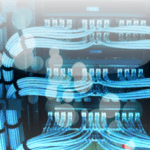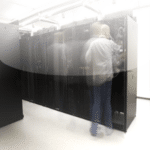Low smoke zero halogen or low smoke free of halogen (LSZH or LSOH or LS0H or LSFH or OHLS) is a material classification typically used for cable jacketing in the wire and cable industry. LSZH cable jacketing is composed of thermoplastic or thermoset compounds that emit limited smoke and no halogen when exposed to high sources of heat.
Most network cables are insulated with polyethylene, PVC or thermoplastic urethane (TPU). In a fire, a halogen-containing plastic material releases hydrogen chloride, a poisonous gas that forms hydrochloric acid when it comes in contact with water. Designated halogen-free cables, on the other hand, do not produce a dangerous gas/acid combination when exposed to flame. However, gases produced by all burning materials—whether LSZH or not—are extremely toxic.
Low smoke zero halogen cable reduces the amount of toxic and corrosive gas emitted during combustion. This type of material is typically used in poorly ventilated areas such as aircraft or rail cars. It is also used extensively in the railroad industry, wherever high voltage or track signal wires must be run into and through underground tunnel systems. This reduces the chance of toxic gasses accumulating in these areas should the wires be damaged by fire or a short circuit fault.
Low smoke zero halogen is becoming very popular and, in some cases, a requirement where the protection of people and equipment from toxic and corrosive gas is critical like in the railway industry.
In Plenum environments a third alternative to PVC or LSZH cable jackets exists and this is Plenum rated cable.











